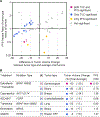Tumor-Specific Activity of Precision Medicines in the NCI-MATCH Trial
- PMID: 38109210
- PMCID: PMC10922532
- DOI: 10.1158/1078-0432.CCR-23-0983
Tumor-Specific Activity of Precision Medicines in the NCI-MATCH Trial
Abstract
Purpose: National Cancer Institute Molecular Analysis for Therapy Choice (NCI-MATCH) is a precision medicine basket trial designed to test the effectiveness of treating cancers based on specific genetic changes in patients' tumors, regardless of cancer type. Multiple subprotocols have each tested different targeted therapies matched to specific genetic aberrations. Most subprotocols exhibited low rates of tumor shrinkage as evaluated across all tumor types enrolled. We hypothesized that these results may arise because these precision cancer therapies have tumor type-specific efficacy, as is common among other cancer therapies.
Experimental design: To test the hypothesis that certain tumor types are more sensitive to specific therapies than other tumor types, we applied permutation testing to tumor volume change and progression-free survival data from 10 published NCI-MATCH subprotocols (together n = 435 patients). FDR was controlled by the Benjamini-Hochberg procedure.
Results: Six of ten subprotocols exhibited statistically significant evidence of tumor-specific drug sensitivity, four of which were previously considered negative based on response rate across all tumors. This signal-finding analysis highlights potential uses of FGFR tyrosine kinase inhibition in urothelial carcinomas with actionable FGFR aberrations and MEK inhibition in lung cancers with BRAF non-V600E mutations. In addition, it identifies low-grade serious ovarian carcinoma with BRAF v600E mutation as especially sensitive to BRAF and MEK co-inhibition (dabrafenib plus trametinib), a treatment that received accelerated FDA approval for advanced solid tumors with BRAF v600E mutation.
Conclusions: These findings support the value of basket trials because even when precision medicines do not have tumor-agnostic activity, basket trials can identify tumor-specific activity for future study.
©2023 American Association for Cancer Research.
Conflict of interest statement
Disclosures: A.C. Palmer reports personal fees from Merck, AstraZeneca and Kymera outside the submitted work, and research funding from Prelude Therapeutics outside the submitted work. The other authors declare no potential conflicts of interest.
Figures


Update of
-
Tumor-specific activity of precision medicines in the NCI-MATCH trial.medRxiv [Preprint]. 2023 Mar 31:2023.03.30.23287951. doi: 10.1101/2023.03.30.23287951. medRxiv. 2023. Update in: Clin Cancer Res. 2024 Feb 16;30(4):786-792. doi: 10.1158/1078-0432.CCR-23-0983. PMID: 37034644 Free PMC article. Updated. Preprint.
Similar articles
-
Tumor-specific activity of precision medicines in the NCI-MATCH trial.medRxiv [Preprint]. 2023 Mar 31:2023.03.30.23287951. doi: 10.1101/2023.03.30.23287951. medRxiv. 2023. Update in: Clin Cancer Res. 2024 Feb 16;30(4):786-792. doi: 10.1158/1078-0432.CCR-23-0983. PMID: 37034644 Free PMC article. Updated. Preprint.
-
FDA Approval Summary: Dabrafenib and Trametinib for the Treatment of Metastatic Non-Small Cell Lung Cancers Harboring BRAF V600E Mutations.Oncologist. 2018 Jun;23(6):740-745. doi: 10.1634/theoncologist.2017-0642. Epub 2018 Feb 7. Oncologist. 2018. PMID: 29438093 Free PMC article.
-
Dabrafenib plus trametinib in patients with previously treated BRAF(V600E)-mutant metastatic non-small cell lung cancer: an open-label, multicentre phase 2 trial.Lancet Oncol. 2016 Jul;17(7):984-993. doi: 10.1016/S1470-2045(16)30146-2. Epub 2016 Jun 6. Lancet Oncol. 2016. PMID: 27283860 Free PMC article. Clinical Trial.
-
Expanding the Benefit: Dabrafenib/Trametinib as Tissue-Agnostic Therapy for BRAF V600E-Positive Adult and Pediatric Solid Tumors.Am Soc Clin Oncol Educ Book. 2023 May;43:e404770. doi: 10.1200/EDBK_404770. Am Soc Clin Oncol Educ Book. 2023. PMID: 37159870 Review.
-
Efficacy of Dabrafenib and Trametinib in a Patient with Squamous-Cell Carcinoma, with Mutation p.D594G in BRAF and p.R461* in NF1 Genes-A Case Report with Literature Review.Int J Mol Sci. 2023 Jan 7;24(2):1195. doi: 10.3390/ijms24021195. Int J Mol Sci. 2023. PMID: 36674722 Free PMC article. Review.
Cited by
-
HER2 and urothelial carcinoma: current understanding and future directions.Nat Rev Urol. 2025 Aug 15. doi: 10.1038/s41585-025-01075-x. Online ahead of print. Nat Rev Urol. 2025. PMID: 40817396 Review.
-
Agnostic Administration of Targeted Anticancer Drugs: Looking for a Balance between Hype and Caution.Int J Mol Sci. 2024 Apr 7;25(7):4094. doi: 10.3390/ijms25074094. Int J Mol Sci. 2024. PMID: 38612902 Free PMC article. Review.
-
Companion Tests and Personalized Cancer Therapy: Reaching a Glass Ceiling.Int J Mol Sci. 2024 Sep 17;25(18):9991. doi: 10.3390/ijms25189991. Int J Mol Sci. 2024. PMID: 39337479 Free PMC article. Review.
-
Novel clinical trial designs emerging from the molecular reclassification of cancer.CA Cancer J Clin. 2025 May-Jun;75(3):243-267. doi: 10.3322/caac.21880. Epub 2025 Jan 22. CA Cancer J Clin. 2025. PMID: 39841128 Free PMC article. Review.
References
-
- Hanahan D & Weinberg RA The hallmarks of cancer. Cell 100, 57–70 (2000). - PubMed
-
- Druker BJ et al. Efficacy and safety of a specific inhibitor of the BCR-ABL tyrosine kinase in chronic myeloid leukemia. N Engl J Med 344, 1031–1037 (2001). - PubMed
-
- Woodcock J & LaVange LM Master Protocols to Study Multiple Therapies, Multiple Diseases, or Both. N Engl J Med 377, 62–70 (2017). - PubMed
MeSH terms
Substances
Grants and funding
LinkOut - more resources
Full Text Sources
Medical
Research Materials

